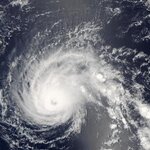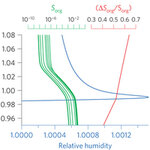Atmospheric

Temperatures in central China are 10 to 14 degrees Fahrenheit hotter today than they were 20,000 years ago - an increase two to four times greater than many scientists previously thought.
20,000 years ago was an ice age but more rigorous understanding of baselines will help researchers develop more accurate models of past climate conditions and that will lead to better predictions about the future.
Since the last ice age, numerous factors have influenced changes in global wind and precipitation patterns in Earth's atmosphere. Atmospheric processes move in relation to a…

We, the people, have understood. We've got it. Too much CO2 is spewed out in the atmosphere! The problem is that we, the people, understood this like 'a million' years ago. I wish those who scream '400 ppm, 400 ppm, 400 ppm!' now would have understood that screaming 400 ppm, 400 ppm, 400 ppm! does not inspire people to act. It only makes the fanatics join the choirs of screaming and the rest of us to shrug our shoulders and say 'Oh, here they go again! Armageddon it is.'
Screaming 400 ppm doesn't help much. Here another scream, freely after the famous painting Scream artist…

Cirrus clouds, the thin wisps of vapor that coalesce in the upper layers of the troposphere and trail across the sky, often more than 10 miles above the Earth's surface, influence our global climate, cooling the planet by reflecting incoming solar radiation and warming it by trapping outgoing heat.
Understanding the mechanisms by which these clouds form would help scientists make accurate predictions about future climate patterns.
A team has identified the major seeds on which cirrus clouds form. The team sampled cirrus clouds using instruments aboard high-altitude research aircraft,…

Hawaii does not get a lot of hurricanes, only two have made landfall in the last 30 years.
But scientists at the International Pacific Research Center, University of Hawaii at Manoa predict that Hawaii could see a two-to-three-fold increase in tropical cyclones by 2075.
How worried should Hawaii residents get?
Climate models have predicted fewer hurricanes overall but with so many variables in a complex system like the climate, it is hard to be sure a numerical model can accurately predict hurricane frequency in a local area.
To try and get an answer, lead author Hiroyuki…

The World Is Getting Cooler*
* Not!This is something of a pre-emptive strike against the quote miners of this world. I predict that they will use a new study of cloud seeding to sell ice damage insurance or something.
If you sprinkle a cup of water on a bonfire it will have a tiny cooling effect. It will not put out the fire or wishomagically reverse the heating effect. Scientists know exactly what they mean by a cooling effect, and so does everyone who ever used a cooling fan in summer. But there are some snake oil salesmen who want to convince you that a simple…

Natural emissions and man-made pollutants have an unexpected effect; they make clouds brighter and have a cooling effect on the world's climate.
A quick primer: Clouds are made of water droplets, condensed on to tiny particles suspended in the air. When the air is humid enough, the particles swell into cloud droplets. It has been known for some decades that the number of these particles and their size control how bright the clouds appear from the top, controlling the efficiency with which clouds scatter sunlight back into space. A major challenge for climate science has been trying to…

Rainfall over the Hawaiian Islands has been declining since 1978.
Is the drying trend due to global warming? Yes, says a team of researchers who found that climate models don't have enough resolution to capture the diverse rainfall pattern over Hawaii, where dry and wet areas often lie only a mile or even less apart, and so devised a method called 'statistical downscaling.'
They first got a take on the effects of the general drying trend on local heavy-rain days by reanalyzing observations from 1978 to 2010 at 12 rain-gauge stations spread throughout the islands. Studying…

Thermoelectric power plants interact with climate, hydrology, and aquatic ecosystems while rivers serve as "horizontal cooling towers" — but at a cost to the environment, says a new analysis.
90% of the electricity in the US is created by power plants that boil water and create steam that drives turbines to produce electricity. Cooling the waste heat generated during the process requires that high volumes of water be used. The thermoelectric sector is the largest user of freshwater in the U.S. - energy companies use more water than agriculture.
Water withdrawals are either…

While the United States is now back at early 1990s levels of CO2 emissions, thanks to a switch to natural gas in the energy sector and a moribund economy, that doesn't apply to Asia. The middle class in China alone has a population that exceeds the entire USA and they all want, and are getting, cars and air conditioners and a better life and the emissions to go along with it. Globally, greenhouse gas emissions have continued to rise but warming, the telltale sign of climate change, has not.
Since 2000, global warming has tapered off and virtually no one in the climate science community…

An analysis of how carbon is trapped and released by iron-rich volcanic magma offers clues about our early atmospheric evolution and also that of other terrestrial bodies.
The composition of a planet's atmosphere starts far beneath the surface. When mantle material melts to form magma, it traps subsurface carbon. As magma moves upward toward the surface and pressure decreases, that carbon is released as a gas. On Earth, carbon is trapped in magma as carbonate and degassed as carbon dioxide, a greenhouse gas that helps Earth's atmosphere trap heat from the sun. But how carbon is transferred…